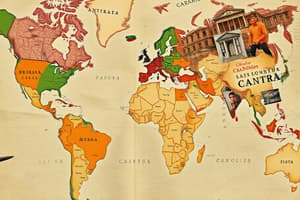Podcast
Questions and Answers
Physical maps illustrate natural features like mountains, rivers, and ______.
Physical maps illustrate natural features like mountains, rivers, and ______.
lakes
Political maps show governmental boundaries, cities, and significant ______.
Political maps show governmental boundaries, cities, and significant ______.
infrastructures
The ______ projection preserves shape but distorts size, especially near the poles.
The ______ projection preserves shape but distorts size, especially near the poles.
Mercator
Understanding symbols and legends is crucial for effective ______ of maps.
Understanding symbols and legends is crucial for effective ______ of maps.
GIS stands for Geographic Information ______.
GIS stands for Geographic Information ______.
Overlay analysis combines multiple layers of data to identify ______.
Overlay analysis combines multiple layers of data to identify ______.
Large scale maps cover a small area with ______ features.
Large scale maps cover a small area with ______ features.
Choropleth maps use ______ coding to represent data values in defined areas.
Choropleth maps use ______ coding to represent data values in defined areas.
Flashcards are hidden until you start studying
Study Notes
Human Geography Study Notes
Map Types
- Physical Maps: Illustrate natural features like mountains, rivers, and lakes.
- Political Maps: Show governmental boundaries, cities, and significant infrastructures.
- Thematic Maps: Focus on specific themes or subjects such as population density, climate, or economic activities.
- Choropleth Maps: Use color coding to represent data values in defined areas.
- Dot Distribution Maps: Employ dots to show the presence of a feature with each dot representing a specific quantity.
- Flow Maps: Depict the movement of people, goods, or ideas between locations.
Scale and Projections
-
Map Scale:
- Represents the relationship between distance on the map and distance on the ground.
- Large Scale: Covers a small area with detailed features (e.g., city maps).
- Small Scale: Covers a large area with less detail (e.g., world maps).
-
Map Projections:
- Methods of representing the curved surface of the Earth on a flat surface.
- Mercator Projection: Preserves shape but distorts size, especially near the poles.
- Robinson Projection: Balances size and shape distortions; widely used for world maps.
- Goode's Homolosine Projection: Minimizes distortion of area but interrupts the map's continuity.
Map Interpretation
- Understanding Symbols and Legends: Recognizes different symbols used for specific features or data.
- Analyzing Scale: Assesses how scale affects the presentation of information.
- Identifying Patterns and Relationships: Looks for spatial distributions, trends, and anomalies in data.
- Cognitive Maps: Studies individuals' perceptions and mental representations of spatial information.
GIS Technology
-
Geographic Information Systems (GIS): Computer systems for capturing, storing, analyzing, and managing geographical data.
-
Components:
- Hardware: Computers and GPS devices.
- Software: Applications for data analysis and visualization (e.g., ArcGIS).
- Data: Geographic data and related attributes.
- People: Users who analyze and interpret data.
-
Applications:
- Urban planning, environmental management, resource allocation, and transportation.
Spatial Analysis
-
Definition: Examination of the locations, attributes, and relationships of features in spatial data.
-
Techniques:
- Overlay Analysis: Combines multiple layers of data to identify relationships.
- Buffering: Creates zones around features to analyze impact within specific distances.
- Spatial Statistics: Uses statistical methods to analyze spatial patterns and relationships.
-
Importance: Helps in decision-making, understanding geographical phenomena, and predicting trends based on spatial relationships.
Map Types
- Physical Maps depict natural features like mountains, rivers, and lakes.
- Political Maps showcase governmental boundaries, cities, and significant infrastructure.
- Thematic Maps focus on specific themes, such as population density, climate, or economic activities.
- Choropleth Maps use color coding to represent data values in defined areas.
- Dot Distribution Maps use dots to represent the presence of a feature, with each dot representing a specific quantity.
- Flow Maps depict the movement of people, goods, or ideas between locations.
Scale and Projections
- Map Scale represents the relationship between distance on the map and distance on the ground.
- Large Scale maps cover small areas with detailed features, like city maps.
- Small Scale maps cover large areas with less detail, such as world maps.
- Map Projections are methods of representing the curved surface of the Earth on a flat surface.
- Mercator Projection preserves shape but distorts size, especially near the poles.
- Robinson Projection balances size and shape distortions, making it widely used for world maps.
- Goode's Homolosine Projection minimizes area distortion but interrupts map continuity.
Map Interpretation
- Understanding Symbols and Legends allows for recognizing different symbols for specific features or data.
- Analyzing Scale assesses how scale affects the presentation of information.
- Identifying Patterns and Relationships looks for spatial distributions, trends, and anomalies in data.
- Cognitive Maps study individuals' perceptions and mental representations of spatial information.
GIS Technology
- Geographic Information Systems (GIS) are computer systems for capturing, storing, analyzing, and managing geographical data.
- Components of GIS:
- Hardware: Computers and GPS devices.
- Software: Applications for data analysis and visualization, like ArcGIS.
- Data: Geographic data and related attributes.
- People: Users who analyze and interpret data.
- Applications of GIS: Urban planning, environmental management, resource allocation, and transportation.
Spatial Analysis
- Spatial Analysis examines the locations, attributes, and relationships of features in spatial data.
- Techniques:
- Overlay Analysis combines multiple data layers to identify relationships.
- Buffering creates zones around features to analyze impact within specific distances.
- Spatial Statistics uses statistical methods to analyze spatial patterns and relationships.
- Importance of Spatial Analysis: Helps in decision-making, understanding geographical phenomena, and predicting trends based on spatial relationships.
Studying That Suits You
Use AI to generate personalized quizzes and flashcards to suit your learning preferences.




